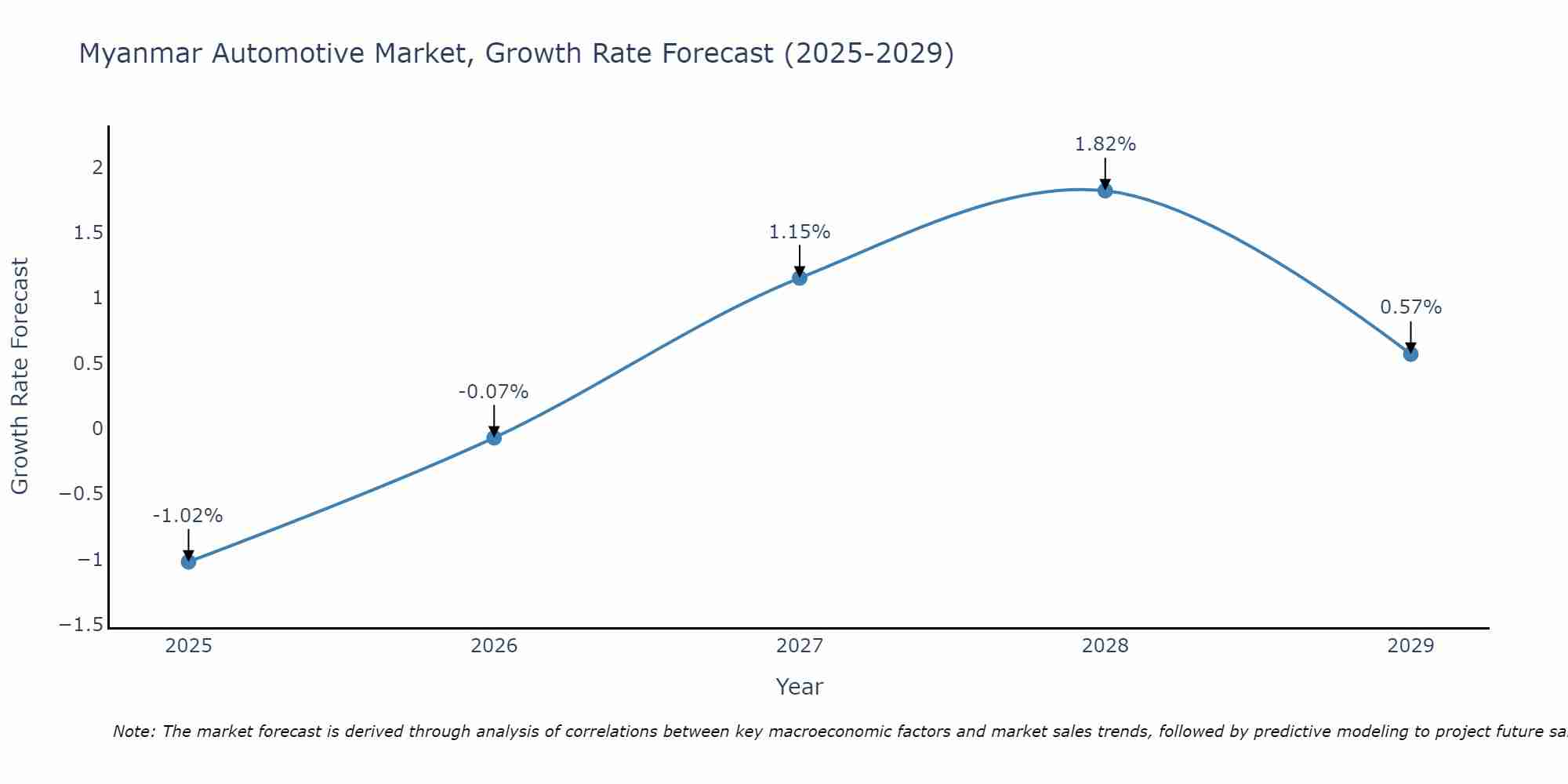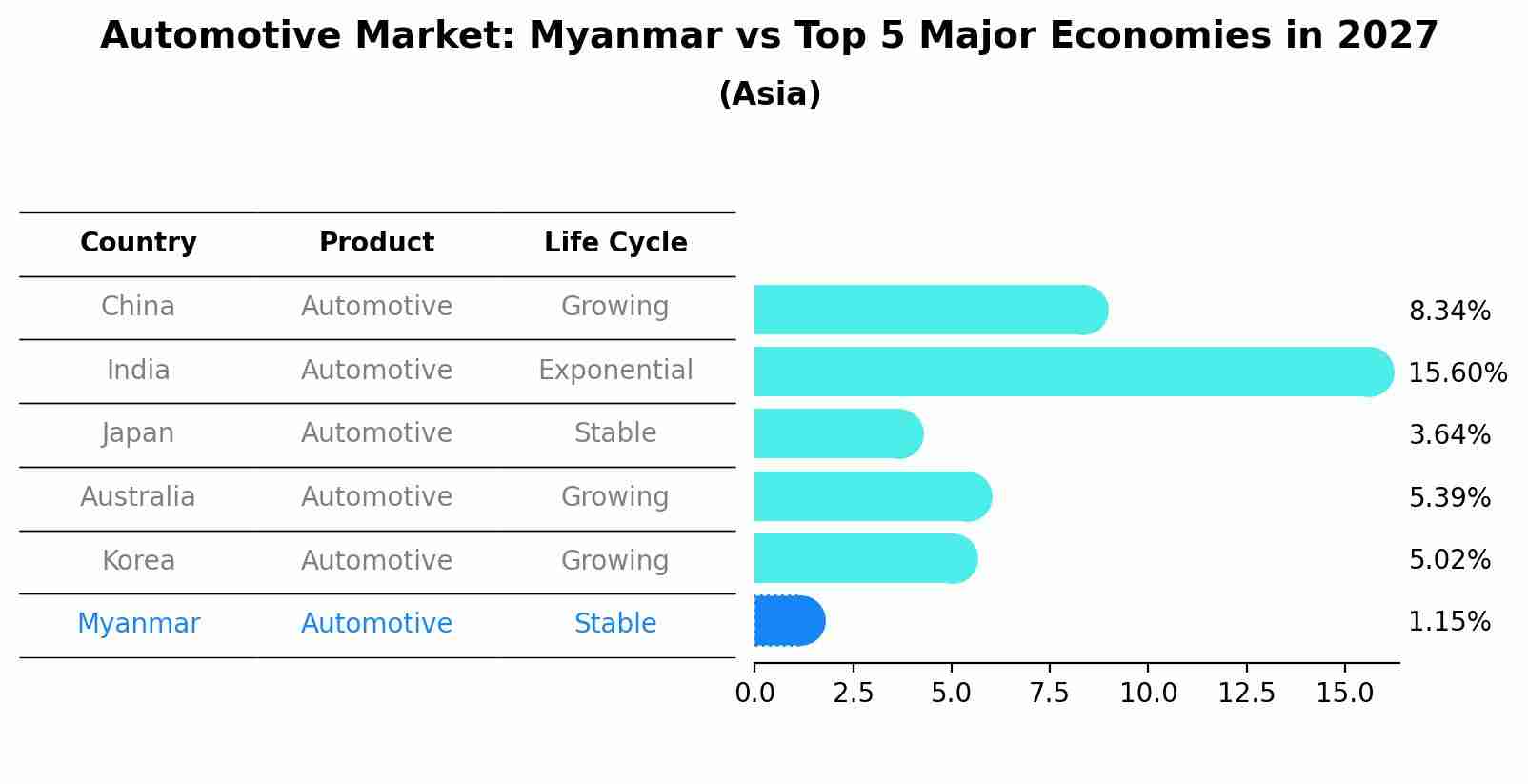Myanmar Automotive Market Outlook | Trends, Size, Companies, Growth, Share, Forecast, Value, Analysis, COVID-19 IMPACT, Industry & Revenue
| Product Code: ETC431790 | Publication Date: Oct 2022 | Updated Date: Jul 2025 | Product Type: Market Research Report | |
| Publisher: 6Wresearch | Author: Dhaval Chaurasia | No. of Pages: 75 | No. of Figures: 35 | No. of Tables: 20 |
Myanmar Automotive Market Size Growth Rate
The Myanmar Automotive Market is projected to witness mixed growth rate patterns during 2025 to 2029. The growth rate begins at -1.02% in 2025, climbs to a high of 1.82% in 2028, and moderates to 0.57% by 2029.

Automotive Market: Myanmar vs Top 5 Major Economies in 2027 (Asia)
In the Asia region, the Automotive market in Myanmar is projected to expand at a stable growth rate of 1.15% by 2027. The largest economy is China, followed by India, Japan, Australia and South Korea.

Myanmar Automotive Market Synopsis
The Myanmar automotive market has shown significant growth in recent years, driven by increasing disposable incomes, urbanization, and infrastructure development. The market is dominated by used car imports, particularly from Japan, due to high import taxes on new vehicles. Japanese brands like Toyota, Nissan, and Honda are popular choices among consumers for their reliability and fuel efficiency. The demand for SUVs and pickups is high, reflecting the country`s rugged terrain and lifestyle preferences. The government`s efforts to improve road infrastructure and regulations are expected to further boost the automotive market. However, challenges such as limited financing options, poor after-sales service, and the prevalence of counterfeit parts hinder the market`s full potential. Overall, the Myanmar automotive market presents opportunities for both local and international automakers to capitalize on the growing demand for vehicles.
Myanmar Automotive Market Trends
In the Myanmar Automotive Market, there is a growing demand for affordable and fuel-efficient vehicles due to the increasing purchasing power of the middle-class population. Electric vehicles are also gaining traction as the government is promoting sustainable transportation solutions to reduce emissions and combat air pollution. Additionally, there is a shift towards more advanced safety features and technology integration in vehicles to meet consumer preferences for convenience and connectivity. The market is witnessing increased competition among automakers, leading to a wider range of options for consumers. However, challenges such as inadequate infrastructure and high import taxes continue to impact the market growth, prompting industry players to adapt strategies to overcome these barriers and capitalize on the emerging opportunities.
Myanmar Automotive Market Challenges
The Myanmar automotive market faces several challenges, including limited infrastructure development, high import taxes on vehicles, and a lack of consumer purchasing power. Inadequate road networks and transportation facilities hinder the growth of the automotive sector, leading to difficulties in distribution and after-sales service. Additionally, the high taxation on imported vehicles makes them considerably more expensive, limiting access to a wider range of vehicles for the population. The overall low average income in Myanmar also restricts the purchasing power of consumers, making it difficult for many to afford buying and maintaining vehicles. These challenges combined pose obstacles to the growth and development of the automotive market in Myanmar.
Myanmar Automotive Market Investment Opportunities
The Myanmar Automotive Market presents promising investment opportunities due to the country`s growing economy and increasing consumer demand for vehicles. With a low vehicle ownership rate compared to other Southeast Asian countries, there is significant room for growth in the automotive sector. Investors can explore opportunities in vehicle manufacturing, distribution, sales, and aftermarket services. Additionally, the government`s efforts to improve infrastructure and regulations related to the automotive industry further enhance the investment landscape. Collaborating with local partners, understanding consumer preferences, and navigating regulatory challenges will be key factors for success in tapping into this burgeoning market. Overall, the Myanmar Automotive Market offers potential for long-term growth and profitability for savvy investors looking to capitalize on the country`s evolving automotive industry.
Jordan Agar Market Government Policies
The government of Myanmar has implemented several policies to regulate the automotive market in the country. These policies include import restrictions on used vehicles to encourage the purchase of new cars and support the local automotive industry. Additionally, there are taxation measures in place, such as high import duties and registration fees, to control the number of vehicles on the road and generate revenue for the government. The government also aims to promote road safety and reduce pollution through regulations on vehicle emissions and safety standards. Overall, these policies are designed to manage the growth of the automotive market in Myanmar while addressing environmental and safety concerns.
Myanmar Automotive Market Future Outlook
The future outlook for the Myanmar automotive market appears promising, driven by factors such as rising disposable incomes, improving infrastructure, and a growing urban population. The demand for vehicles is expected to increase as more consumers in Myanmar seek personal mobility and convenience. Additionally, government initiatives to upgrade road networks and enhance public transportation systems are likely to further boost the automotive market. The entry of new players, advancements in technology leading to the availability of more fuel-efficient and environmentally friendly vehicles, and a shift towards electric vehicles are also expected to shape the market`s future growth. However, challenges such as regulatory uncertainties, limited financing options, and infrastructure constraints may impact the market`s expansion to some extent. Overall, the Myanmar automotive market is poised for steady growth in the coming years.
Key Highlights of the Report:
- Myanmar Automotive Market Outlook
- Market Size of Myanmar Automotive Market, 2021
- Forecast of Myanmar Automotive Market, 2031
- Historical Data and Forecast of Myanmar Automotive Revenues & Volume for the Period 2018 - 2031
- Myanmar Automotive Market Trend Evolution
- Myanmar Automotive Market Drivers and Challenges
- Myanmar Automotive Price Trends
- Myanmar Automotive Porter's Five Forces
- Myanmar Automotive Industry Life Cycle
- Historical Data and Forecast of Myanmar Automotive Market Revenues & Volume By Product Type for the Period 2018 - 2031
- Historical Data and Forecast of Myanmar Automotive Market Revenues & Volume By Electric for the Period 2018 - 2031
- Historical Data and Forecast of Myanmar Automotive Market Revenues & Volume By Hybrid Electric for the Period 2018 - 2031
- Historical Data and Forecast of Myanmar Automotive Market Revenues & Volume By Plug-In Hybrid Electric for the Period 2018 - 2031
- Historical Data and Forecast of Myanmar Automotive Market Revenues & Volume By Mild Hybrid for the Period 2018 - 2031
- Historical Data and Forecast of Myanmar Automotive Market Revenues & Volume By Natural Gas for the Period 2018 - 2031
- Historical Data and Forecast of Myanmar Automotive Market Revenues & Volume By Fuel Cell Electric for the Period 2018 - 2031
- Historical Data and Forecast of Myanmar Automotive Market Revenues & Volume By Diesel for the Period 2018 - 2031
- Historical Data and Forecast of Myanmar Electric Automotive Market Revenues & Volume By Petrol for the Period 2018 - 2031
- Myanmar Automotive Import Export Trade Statistics
- Market Opportunity Assessment By Product Type
- Myanmar Automotive Top Companies Market Share
- Myanmar Automotive Competitive Benchmarking By Technical and Operational Parameters
- Myanmar Automotive Company Profiles
- Myanmar Automotive Key Strategic Recommendations
Frequently Asked Questions About the Market Study (FAQs):
- Single User License$ 1,995
- Department License$ 2,400
- Site License$ 3,120
- Global License$ 3,795
Search
Thought Leadership and Analyst Meet
Our Clients
Related Reports
- Australia Briquette Market (2025-2031) | Growth, Size, Revenue, Forecast, Analysis, Trends, Value, Share, Industry & Companies
- Vietnam System Integrator Market (2025-2031) | Size, Companies, Analysis, Industry, Value, Forecast, Growth, Trends, Revenue & Share
- ASEAN and Thailand Brain Health Supplements Market (2025-2031) | Strategy, Consumer Insights, Analysis, Investment Trends, Opportunities, Growth, Size, Share, Industry, Revenue, Segments, Value, Segmentation, Supply, Forecast, Restraints, Outlook, Competition, Drivers, Trends, Demand, Pricing Analysis, Competitive, Strategic Insights, Companies, Challenges
- ASEAN Bearings Market (2025-2031) | Strategy, Consumer Insights, Analysis, Investment Trends, Opportunities, Growth, Size, Share, Industry, Revenue, Segments, Value, Segmentation, Supply, Forecast, Restraints, Outlook, Competition, Drivers, Trends, Demand, Pricing Analysis, Competitive, Strategic Insights, Companies, Challenges
- Europe Flooring Market (2025-2031) | Outlook, Share, Industry, Trends, Forecast, Companies, Revenue, Size, Analysis, Growth & Value
- Saudi Arabia Manlift Market (2025-2031) | Outlook, Size, Growth, Trends, Companies, Industry, Revenue, Value, Share, Forecast & Analysis
- Uganda Excavator, Crane, and Wheel Loaders Market (2025-2031) | Strategy, Consumer Insights, Analysis, Investment Trends, Opportunities, Growth, Size, Share, Industry, Revenue, Segments, Value, Segmentation, Supply, Forecast, Restraints, Outlook, Competition, Drivers, Trends, Demand, Pricing Analysis, Competitive, Strategic Insights, Companies, Challenges
- Rwanda Excavator, Crane, and Wheel Loaders Market (2025-2031) | Strategy, Consumer Insights, Analysis, Investment Trends, Opportunities, Growth, Size, Share, Industry, Revenue, Segments, Value, Segmentation, Supply, Forecast, Restraints, Outlook, Competition, Drivers, Trends, Demand, Pricing Analysis, Competitive, Strategic Insights, Companies, Challenges
- Kenya Excavator, Crane, and Wheel Loaders Market (2025-2031) | Strategy, Consumer Insights, Analysis, Investment Trends, Opportunities, Growth, Size, Share, Industry, Revenue, Segments, Value, Segmentation, Supply, Forecast, Restraints, Outlook, Competition, Drivers, Trends, Demand, Pricing Analysis, Competitive, Strategic Insights, Companies, Challenges
- Angola Excavator, Crane, and Wheel Loaders Market (2025-2031) | Strategy, Consumer Insights, Analysis, Investment Trends, Opportunities, Growth, Size, Share, Industry, Revenue, Segments, Value, Segmentation, Supply, Forecast, Restraints, Outlook, Competition, Drivers, Trends, Demand, Pricing Analysis, Competitive, Strategic Insights, Companies, Challenges
Industry Events and Analyst Meet
Whitepaper
- Middle East & Africa Commercial Security Market Click here to view more.
- Middle East & Africa Fire Safety Systems & Equipment Market Click here to view more.
- GCC Drone Market Click here to view more.
- Middle East Lighting Fixture Market Click here to view more.
- GCC Physical & Perimeter Security Market Click here to view more.
6WResearch In News
- Doha a strategic location for EV manufacturing hub: IPA Qatar
- Demand for luxury TVs surging in the GCC, says Samsung
- Empowering Growth: The Thriving Journey of Bangladesh’s Cable Industry
- Demand for luxury TVs surging in the GCC, says Samsung
- Video call with a traditional healer? Once unthinkable, it’s now common in South Africa
- Intelligent Buildings To Smooth GCC’s Path To Net Zero


















